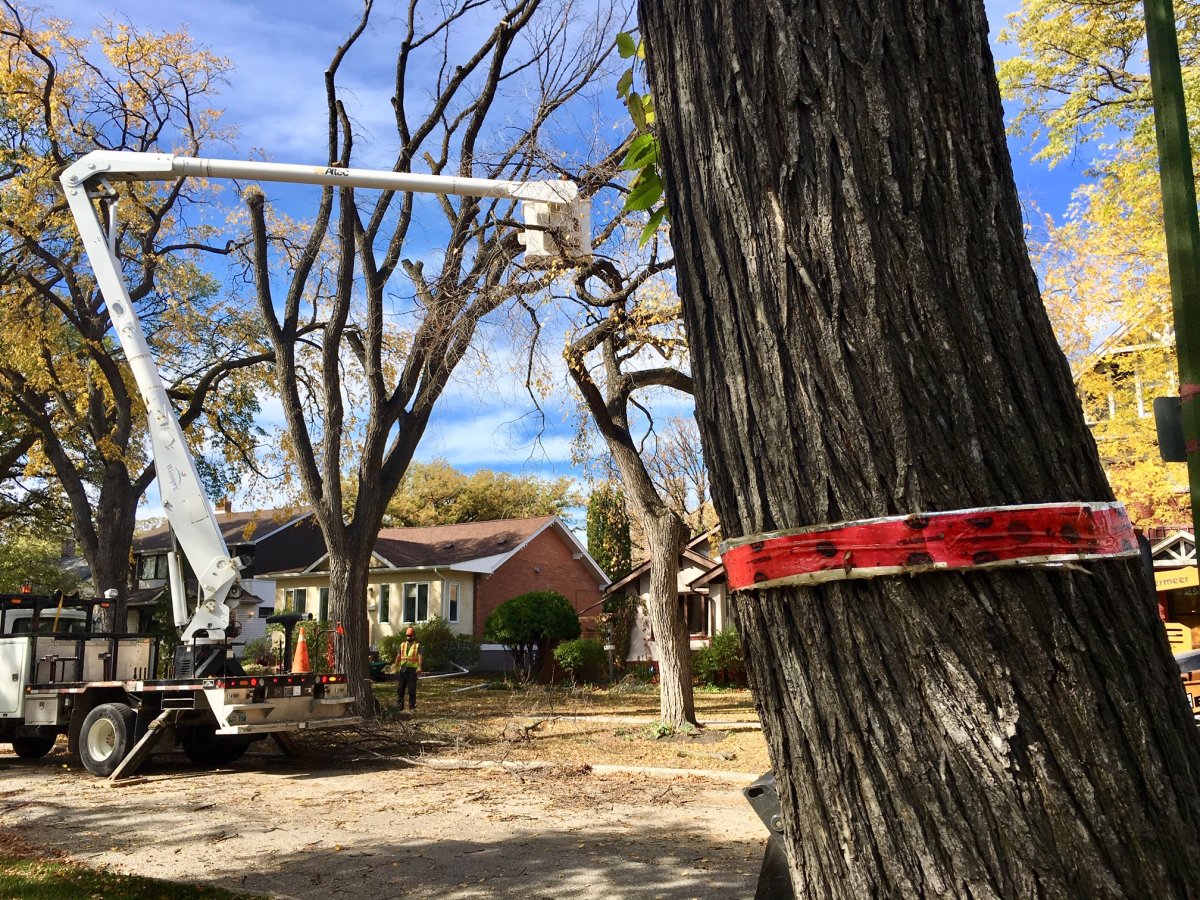With threats mounting against Winnipeg’s urban forest, the city is trying something new to help protect and manage our tree canopy — long-term planning.

The city is turning to Winnipeggers for help completing an urban forest strategy, a 20-year plan covering invasive forest pest management, tree maintenance and pruning, tree planting, as well as tree protection and preservation.
Once it’s completed, Winnipeg’s city forester Martha Barwinsky says it will be the first time in more than a century of tree planting the city will have such a blueprint.
And there are more than a few challenges facing Winnipeg’s estimated 3.1 million trees.
“We’ve got the invasive pests, but also we’ve got development happening in the city … we need a plan,” said Barwinsky.
“It’s to provide a framework and direction … on what’s important and what we need to prioritize in our urban forest management and, really, how we’re going to manage it … considering all of the challenges.”

The early-season snowstorm that blew through one year ago at Thanksgiving, bringing down an estimated 30,000 of the city’s 300,000 boulevard and park trees, evidence of the constant risk of an unpredictable changing climate.
And city foresters have for years been battling invasive pests like Dutch Elm Disease (DED) and Emerald Ash Borer (EAB), serious threats expected to take out a much larger swath of the city’s canopy in the coming years.
While the city has been able to at least manage the spread of DED, which first appeared in the city in 1975, Barwinsky said that’s not the case for the threats facing Winnipeg’s ash trees since EAB arrived in 2017.
Despite efforts to treat healthy ash trees, the city expects all of Winnipeg’s 350,000 ash trees — 100,000 of which are located in public parks and on boulevards — will eventually be killed by the beetle over the next 10-20 years.

“You can’t eradicate it and because it is so insidious, there are trees that appear perfectly healthy but they’re loaded with Emerald Ash Borers,” explained Barwinsky.
“You’re really just managing the mortality.”
To make matters worse, Barwinsky says Winnipeg’s ash are also under attack from another invasive pest, Cottony Ash Psyllid, which she says is currently taking out trees — specifically Black Ash — at an even faster clip than EAB.
The invasive pest, commonly known as jumping tree lice, arrived in Winnipeg in 2017, and Barwinsky says it’s mostly to blame for the roughly 1,000 ash trees city crews were forced to remove last year.
The city also lost some 9,500 elm trees to DED last year, says Barwinsky, and replanting efforts — which saw 1,400 new trees added to Winnipeg’s online tree inventory in 2019 — aren’t keeping up with the growing losses.
- Ontario takes action against chemical plant after Aamjiwnaang First Nation residents fell ill
- High benzene levels detected near Ontario First Nation for weeks, residents report sickness
- Enter at your own risk: New home security camera aims paintballs at intruders
- Beijing orders Apple to pull WhatsApp, Threads from its China app store
The city says the urban forest strategy has grown out of the Urban Forest Enhancement Capital Project, a plan approved by council in December 2017 in response to a report on the additional resources needed for DED management and in preparation for the arrival of EAB.
‘We really have to diversify how we plant’
While dealing with invasive pests will be an integral part of the city’s new plan, Barwinsky says the strategy will also help guide decision-making going forward too.
A city website with details on the project says the strategy will be used to “develop policy, recommendations, and strategic actions to help protect, preserve, and grow the canopy well into the future.”
That’s good news, says Trees Winnipeg president Gerry Engel.
Engel, who has worked for years as a private arborist in Winnipeg, says having a clearly laid-out plan may help the city avoid making decisions that, with the benefit of hindsight, turn out to be mistakes.
Among the most detrimental decisions, says Engel, has been the mass planting of single tree species in Winnipeg — first elm and then ash after the arrival of DED.
The resulting monocultures — which have left roughly 60 per cent of the city’s canopy made up of either elm or ash trees — mean the city is now at risk of losing much of its canopy to insects and disease.

“We really have to diversify how we plant, you know — what we plant — and have good diversity in our urban forest,” he said.
“There’s a place for monoculture in a certain design, in a certain, small, small design, but lining the streets of whole entire neighbourhoods with the same species of tree is not a good idea.”
The city says it expects to have the strategy’s final draft finished and ready to implement by the fall of 2021, and Engel says he hopes the resulting plan puts a focus on better protecting Winnipeg’s elms.
He says the city needs to both detect sick trees quickly and remove them before the disease can spread.
“We’ve not been able to keep up with that timing as a city, and that’s really concerning,” he said.
“I would love to see us gain control of Dutch Elm Disease and maintain these iconic trees in our neighbouhoods for as long as we can because they are the most unique natural feature that we have in the city other than two rather temperamental rivers.”

Winnipeggers can provide input on the strategy by taking part in an online survey until Nov. 1. More information on the project is available here.
Engel is hopeful Winnipeggers embrace the opportunity to play a role and have a say in the future of our tree canopy.
“Let’s plant as many trees as we can, properly, so we create the legacy for our city and we carry that on into the future,” he said.
“It’s such an important part of our infrastructure that just really doesn’t get talked about that way.”





Comments